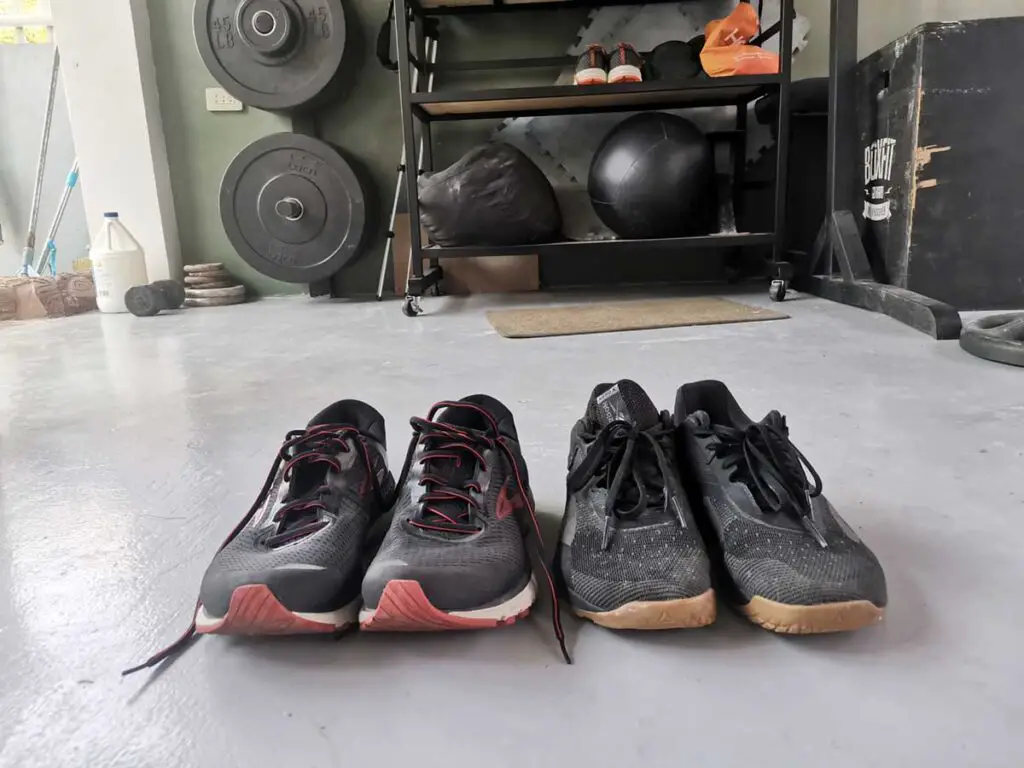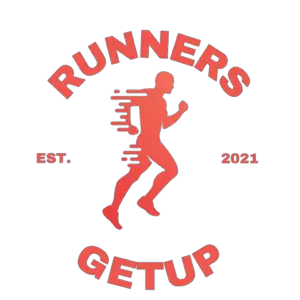This post contains affiliate links.
I’ve always wondered, can running shoes be used in the gym? After all, they provide good cushioning and they fit really well.
After years of using different types of shoes (including running shoes) to the gym and doing all types of workouts from weightlifting to agility drills to gymnastics and plyometrics, here’s what I’ve found.
Yes, running shoes can be used in the gym. But be aware that you cannot do lifts that involve ground stability like squats, weightlifting, standing presses, and deadlifts. Doing so may compromise your safety as well as damage your running shoe.
Ahead, we will take a look at what other exercises running shoes can be used for, what’s the difference between running shoes and training shoes, what running shoes and training shoes are best for, and how to choose the right training shoe for you.
Why You Shouldn’t Use Running Shoes For Heavy Lifting
Running shoes cannot be used for functional and technical exercises like squats, deadlifts, standing presses, snatch and cleans because it does not provide enough stability and ground contact.
Running shoes are built to provide better cushioning in the foot in order to absorb the impact from the repetitive pounding of your body weight to the ground. This impact can reach up to 3x your body weight which is why running shoes are equipped with a softer cushioning that leads to a higher stack height.
Because the cushion of the shoe is soft and the height of the shoe is high, it results in a lesser degree of stability. Not to mention, some running shoes like the ASICS GlideRide 2 are equipped with soles designed to roll forward which is fantastic for running but a big no-no for lifting.
Some exercises, including lifts, are okay with running shoes though. As long as it does not need ground stability and lateral movements.
Good examples of these lifts are bench press, bicep curls, lateral raises, and other open-chain exercises.
Another reason why you shouldn’t use running shoes for lifting heavy weights is that doing so may damage the shoes’ delicate midsole. Because running shoes have a more advanced midsole technology than training shoes, they must be provided with care.
As a matter of fact, I highly recommend using running shoes solely for the activity of running to extend its lifespan.
Lifting weights while using a running shoe may apply too much weight on its midsole that may cause it to not return to its normal form. When that happens, you’re running shoe is basically done and you will have to replace them prematurely.
If you own a pair of running shoes and wonder when you should change them, I made an article detailing 7 signs that you need to change your running shoe.
Other Exercises That Can Be Done With Running Shoes
As mentioned, you can’t use running shoes for exercises that need ground stability. But there are some exercises, even with weights, that are okay to do using running shoes.
- Bench press
- Seated press
- Machine-based bodybuilding
- Light accessory lifts
- Core exercises
- Calisthenics
- Bodyweight exercises
- Zumba
- Jumping ropes
Any lift that does not require you on your feet is fine, that could range from bicep curls to lateral raises. Also, any bodyweight exercises that do not require aggressive lateral movements are fine.
Running Shoes Vs. Training Shoes: What’s the Difference?

Most people think these two are interchangeable. True, you can use a running shoe to do some non-running training and use a training shoe for very short distance running, but there are quite a few differences among these two that make them very different.
Running Shoes
- Built with better cushioning to protect knees against ground impact when running
- Built for linear, forward movement
- Increases running efficiency
- High stack-height and heel-toe-drop
- Built to transition from heelstrike to toe-off
Training Shoes
- Firmer cushioning
- Built for multi-directional movements
- More ground contact
- A flatter sole leads to increased ground stability
Although these shoes are very much different, to say that one shoe is better than the other is like comparing apples from bananas. Both shoes do well for the activity they’re made for.
What are Running Shoes Best For?
Since running shoes are built high and have way better cushioning than training shoes, it is best to use running shoes for high-impact exercises like running. Not only that! Running shoes are also great for other high-impact exercises such as jumping ropes, broad jumps, and box jumps.
If you’ve been running with a training shoe all this time, I suggest you start investing in a real running shoe. They will provide you with better comfort and better shock absorption that will give you better protection against overuse injuries.
For beginners looking for a running shoe, I suggest you start with a daily trainer that could handle both speed workouts as well as long-distance runs like the Brooks Ghost 13. You can get it on Amazon.
What are Training Shoes Best For?
Since training shoes have better stability and a flatter sole, they cater to more exercises than running shoes.
They can be used for a lot of exercises including those that involve stability and lateral movements like weightlifting, high-intensity interval training, side to side drills, strength exercises, agility training, CrossFit and even short distance runs.
They are more versatile and less sports-focused.
A lot of shoes are included in this category, including all the shoes used in CrossFit like the Nike Metcon and the NOBULL Trainers.
How to Choose a Training Shoe?
Choosing a training shoe should depend on your activities. A very firm and stable shoe will not necessarily feel comfortable for agility athletes who rely on the cushioning and responsiveness of the shoe. In contrast, a more flexible and cushioned training shoe will not work well for those who do lots of weightlifting like Crossfit athletes.
Here are some pointers and shoe recommendations for different types of exercises other than running.
CrossFit and Strength-Based Exercises
CrossFit involves every functional exercise you can find from weightlifting to gymnastics, rope climbs, jumping ropes, and so on. Because of that, CrossFit shoes need to be stable enough to lift, flexible enough to do plyometrics, cushioned enough to run, and light enough for gymnastics.
Sadly, they do not excel in one thing or the other, but CrossFit shoes can do them all. Yes, that’s right CrossFit shoes are made to be a jack of all trades, just like CrossFit athletes.
One of my favorite training shoes is the Reebok Nano X. They provide great stability for snatches and clean & jerks, but are flexible enough for box jumps and burpees. Not to mention, it’s equipped with rope grips for rope climbs.
Because it’s flat and provides good stability, this is also the shoe I use for all my strength exercises from squats to deadlifts to shoulder presses.
They are well built and are available in different stylish designs.
Agility Exercises
For agility-based exercises that require more ground contact and speed, I highly recommend using a minimalist shoe like the WITHIN cross-trainer. Despite having less cushioning, a minimalist shoe is lighter and makes you feel more connected with the ground that is necessary for agility work.
Examples of agility work are:
- Side-to-side drills
- box jump drills
- Plyometrics
- Speed ladder
- Dot drills
- Shuttle runs
You can go side-to-side, jump, roll, and slide without any interference. Plus, it has 0 heel-to-toe drop which means you’ll basically feel like you’re barefooted making it easier to change directions and maneuver.
Best of all? They’re cheaper than other types of trainers.
Olympic Weightlifting
Snatches and Clean & Jerks are the most technical lifts of all. They involve a great level of skill, stability, and strength.
Weightlifting shoes are nothing like any other trainers. They are very firm, provide 0 cushioning, and are very very stable. The heel is also slightly elevated to provide more range of motion in the squat position.
I used to spend a lot of time weightlifting and have used different weightlifting shoes. But the best one I’ve tried was the Adidas Adipower.
However, these shoes are not great for doing different activities other than weightlifting, squatting, and any overhead press. These are very firm and stiff shoes that could feel uncomfortable if you use them for the wrong activity.
That is why I only recommend this shoe for those who are serious about getting better at weightlifting. If you just want to do snatches and cleans as a part of a high-intensity workout, you’re fine with using a CrossFit shoe.
The Wrap Up
Different types of shoes are made for different types of activities. Although you can basically use running shoes in the gym, you cannot do everything in a running shoe.
If you want to be able to lift and do other types of exercises, it is always better to just invest in a training shoe for your safety and to avoid damaging your shoe.



